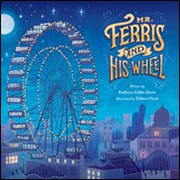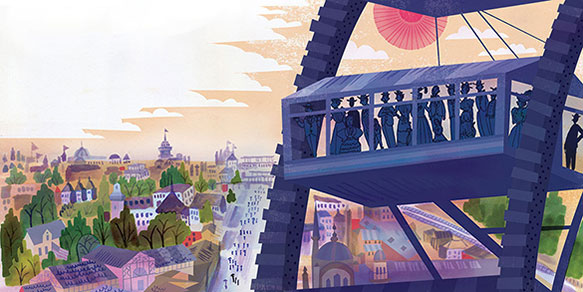|
| |
 |
|
|
|
Once you've bought
Mr. Ferris and His Wheel, receive a personalized bookplate, along with a free bookmark. Use our contact form to send us the recipient(s)' names, postal mail address, and zipcode. We'll mail them at no charge to you. |
|
| back to books |
|
|
|
|
|
| |
BOOKS |
|
|
|
|
|
Mr. Ferris and His Wheel |
|
|
|
|
| |
written by Kathryn Gibbs Davis
illustrated by Gilbert Ford
Houghton Mifflin Harcourt Children's Books, 2014 |
|
|
|
|
| |
Capturing an engineer's creative vision and mind for detail, this fully illustrated picture book biography sheds light on how the American inventor George Ferris defied gravity and seemingly impossible odds to invent the world's most iconic amusement park attraction, the Ferris wheel. |
|
|
|
|
| |
A fun, fact-filled text by Kathryn Gibbs Davis combines with Gilbert Ford's dazzling full-color illustrations to transport readers to the 1893 World's Fair, where George Ferris and his big, wonderful wheel lifted passengers to the skies for the first time. |
|
| |
|
|
| |
 |
|
|
|
|
| |
Interior illustration from Mr. Ferris and His Wheel. Illustration © Gilbert Ford. Used with permission. |
|
| |
|
|
| |
AWARDS AND DISTINCTIONS |
|
|
|
|
| |
Junior Library Guild selection
American Scientist, Gift Guide 2014: Books on Science, Tech, Engineering, and Math
Bank Street College Center for Children's Literature, Cook Prize (STEM) Finalist
Barnes & Noble 2014: “This Season’s Best Books for Aspiring Young Builders”
BookPage magazine
CCBC 2015 Choices, Cooperative Children's Book Center, University of Wisconsin
Chicago Public Library Best Books of 2014
Chicago Tribune's 2015 Children's Read & Write Program
Huffington Post, "26 Entertaining and Educational Books for Back-to-School Season"
Nerdy Book Club Award for Nonfiction Picture Books 2014
Oppenheim Best Books, Platinum and Gold Seals
Orbis Pictus Honor Book, NCTE, Outstanding Nonfiction for Children
Society of Illustrators, The Original Art 2014, Exhibition of Children's Book Illustration
Utah's Beehive Book Award nominee, "Information Book" category |
|
|
|
|
|
DON'T MISS OUT ON YOUR BOOKPLATE AND BOOKMARK |
|
|
|
|
|
"Here are the photos of my second-grade readers! They were so excited to have the autographed bookmarks! Thanks!" —from Mary B, a teacher in the Midwest |
|
|
|
|
|
 |
|
|
|
|
|
VIDEO BOOK TRAILER |
|
|
|
|
|
|
|
|
|
|
|
TEACHING GUIDE |
|
|
Here's a teaching guide to aid with lesson planning. Let me know how you use Mr. Ferris and His Wheel in your classroom or send photos! |
|
|
|
|
|
PODCAST |
|
|
|
|
|
Mr. Ferris and His Wheel (on iTunes) as broadcast on |
|
|
|
|
|
The Children's Bookshelf, Dr. Sue Ann Martin and Dr. Pamela S. Gates on WCMU |
|
|
|
|
|
In the archives, look for September 24-26, 2014 |
|
|
|
|
| |
REVIEWS |
|
|
|
|
| |
 Ten months before the 1893 Chicago World’s Fair, there was still no centerpiece to rival that of the previous fair’s Eiffel Tower. Enter young engineer George Washington Gale Ferris Jr., who had a vision of a structure not only tall but also rigged for motion. Having no better choices, fair organizers begrudgingly accepted his proposal but offered not a cent of funding. With but four months to go, George scrambled for funding and materials, most of it a newfangled metal called “steel,” including a 70-ton axle, “the largest piece of steel ever forged.” The harried workers struggled with frozen Chicago ground, unexpected quicksand, more than 100,000 parts, and, most of all, the derision of onlookers who found the spindly-looking contraption undignified and sure to collapse in high winds. But it didn’t—rather, it ascended heavenward into both day and night skies, offering unparalleled views from its posh living-room-sized passenger cars. Like Mr. Ferris’ invention, Davis’ picture-book bio soars, inspires, and keeps (the pages) ever turning, matching the gregarious text to smaller, often tech-based side comments. Ford’s impressionistic, wine-colored washes blend a fantastical mood with a staggering sense of mechanical scale. It’s tough to awe readers with a ride with which they are so familiar, but Davis and Ford pull it off. Grab your tickets; here we go. Ten months before the 1893 Chicago World’s Fair, there was still no centerpiece to rival that of the previous fair’s Eiffel Tower. Enter young engineer George Washington Gale Ferris Jr., who had a vision of a structure not only tall but also rigged for motion. Having no better choices, fair organizers begrudgingly accepted his proposal but offered not a cent of funding. With but four months to go, George scrambled for funding and materials, most of it a newfangled metal called “steel,” including a 70-ton axle, “the largest piece of steel ever forged.” The harried workers struggled with frozen Chicago ground, unexpected quicksand, more than 100,000 parts, and, most of all, the derision of onlookers who found the spindly-looking contraption undignified and sure to collapse in high winds. But it didn’t—rather, it ascended heavenward into both day and night skies, offering unparalleled views from its posh living-room-sized passenger cars. Like Mr. Ferris’ invention, Davis’ picture-book bio soars, inspires, and keeps (the pages) ever turning, matching the gregarious text to smaller, often tech-based side comments. Ford’s impressionistic, wine-colored washes blend a fantastical mood with a staggering sense of mechanical scale. It’s tough to awe readers with a ride with which they are so familiar, but Davis and Ford pull it off. Grab your tickets; here we go. |
|
|
|
|
| |
—Booklist |
|
|
|
|
| |
It's almost time for the 1893 Chicago World's Fair, and American architects are hoping to design a star attraction to rival the French Eiffel Tower. Mechanical engineer George Washington Gale Ferris Jr., has a daring idea: a huge, round, moving structure made from steel, a new metal unrivaled in both lightness and strength. After overcoming obstacles ranging from mockery to quicksand, Ferris and his team finally complete their wheel, which delights fairgoers and goes on to become a staple of fairgrounds around the world. Librarians familiar with Erik Larson's The Devil in the White City (Random, 2002) already know this story, but the focus here is less on the Chicago World's Fair and more on the process involved in building a mechanical marvel. Details such as why support structures were necessary and how tension wheels work will engage emerging engineers, while those with a less scientific bent can nevertheless appreciate the excitement felt by the Ferris Wheel's very first passengers. The primary story is told in an easy-to-read serif font, and secondary details are added in smaller sans-serif sections. A purple-dominated color scheme contrasts with occasional greens and yellows. Overall, the modernist look, inherently interesting topic, and strong documentation (including quotations from primary sources) make this title a positive addition, especially those looking to enhance their nonfiction offerings in view of new Common Core standards. |
|
|
|
|
|
—School Library Journal |
|
|
|
|
|
“In [this] picture-book biography, we aren’t so much gobsmacked by beauty as exhilarated by a marvel of doggedness and engineering. Illustrator Gilbert Ford uses slightly goofy figures and a delicious palette of violets, blues, indigos and yellowy greens to represent a bold inventor’s story in Mr. Ferris and His Wheel. Like almost every individual who has created something impressive from nothing but the ideas in his own head, George Washington Gale Ferris Jr. was a bit of an oddball. Growing up in 19th-century Nevada, he had watched a waterwheel at a mill and wished that he could somehow ride on it. It was this boyish longing that inspired him to conceive of a vast invention to wow the public at the 1893 Chicago World’s Fair. France had amazed the world with the Eiffel Tower; why should not America show its flair with a giant wheel? As Kathryn Gibbs Davis explains in this informative and entertaining account, the determined inventor faced obstacles almost as imposing as his wheel would be: no official funding, very little time and quicksand at the building site. Yet by opening day—hurrah!—the wheel turned, and the passengers went “up, up, up” and “quietly floated above the mud and noise” of the fair.” |
|
|
|
|
|
—Wall Street Journal |
|
|
|
|
| |
“Kids who take Ferris wheels for granted should find this history eye-opening.” |
|
|
|
|
| |
—Kirkus Reviews |
|
|
|
|
| |
“Davis’s picture-book account of the Ferris Wheel construction does a first-rate job of capturing the many risks—to civic pride, financial success, and public safety—that attached to the first iteration of what most readers have already enjoyed as a local carnival attraction.” |
|
|
|
|
| |
—Bulletin of the Center for Children's Books |
|
|
|
|
| |
“Davis delivers a tense and satisfying underdog story, while Ford creates a stylized 19th-century landscape.” |
|
|
|
|
| |
—Publishers Weekly |
|
|
|
|
|
“On almost every spread, Davis has managed to weave in assorted facts about the wheel’s invention in a way that will keep youngsters as engaged and enthralled as I was. The story itself flows easily and the artwork is simply lovely to look at. Ford‘s fabulous jewel-toned illustrations of 19th century Chicago took me back in time to an era in the industrial age when even electricity in homes was not yet commonplace. But as the sun set each evening, Ferris’s wheel, with is 3,000 electric light bulbs, lit up the night sky and was visible ‘as far away as forty miles.’ I was happy to learn that after the 1893 Chicago World’s Fair, in 1894 ‘the next Ferris wheel appeared in California on a cliff overlooking the Pacific Ocean.’” |
|
|
|
|
|
—Ronna Mandel, Good Reads with Ronna |
|
|
|
|
|
“Davis captures the suspense of the building process even as she stealthily educates readers about various principles of engineering.” Read more … |
|
|
|
|
|
—Dorothy Dahm, Kidsbiographer |
|
|
|
|
|
“Kathryn Gibbs Davis and Gilbert Ford’s magical Mr. Ferris and His Wheel is a classic beat-the-odds bio set at the end of the 19th century … This is an enchanting ride from start to finish.” |
|
|
|
|
|
—BookPage, America's Book Review |
|
|
|
|
| |
“The engineer George Ferris won the competition to design America’s answer to the Eiffel Tower, then—against staggering odds—built his monumental ‘Monster Wheel’ in time for the 1893 Chicago Exposition. It is fascinating to learn that the Ferris wheel got its start in a whir of patriotic fervor and as a cutting-edge applied science experiment that critics thought insane … a tale of pluck, stick-to-itiveness and mechanical know-how. Gilbert Ford’s stylish illustrations have their fine touches of humor and historical detail.” |
|
|
|
|
| |
—The New York Times |
|
| |
|
|
| |
“Kathryn Gibbs Davis has written a fascinating account of this episode in American history, including quotes and facts. The illustrations by Gilbert Ford are realistic and magical at the same time capturing the environment that was the 1893 World’s Fair.” |
|
|
|
|
| |
—Ruth McNally Barshaw, 3rd Grade Reading |
|
| |
|
|
| |
“In 1892, Americans were impressed with the Eiffel Tower, the star attraction of the World’s Fair. Who would top that in Chicago the following year? George Ferris was an engineer with an idea. His structure would be made of steel, a new material. Strong yet delicate-looking, Ferris’s wheel was a risk that fair officials weren’t willing to fund. Undefeated, the young engineer used his own savings and broke ground in January 1893. The earth was frozen three feet deep. Beneath that was quicksand. How would he ever be able to complete his dream?” |
|
|
|
|
|
—Deborah B. Ford for Junior Library Guild |
|
|
|
|
|
|



